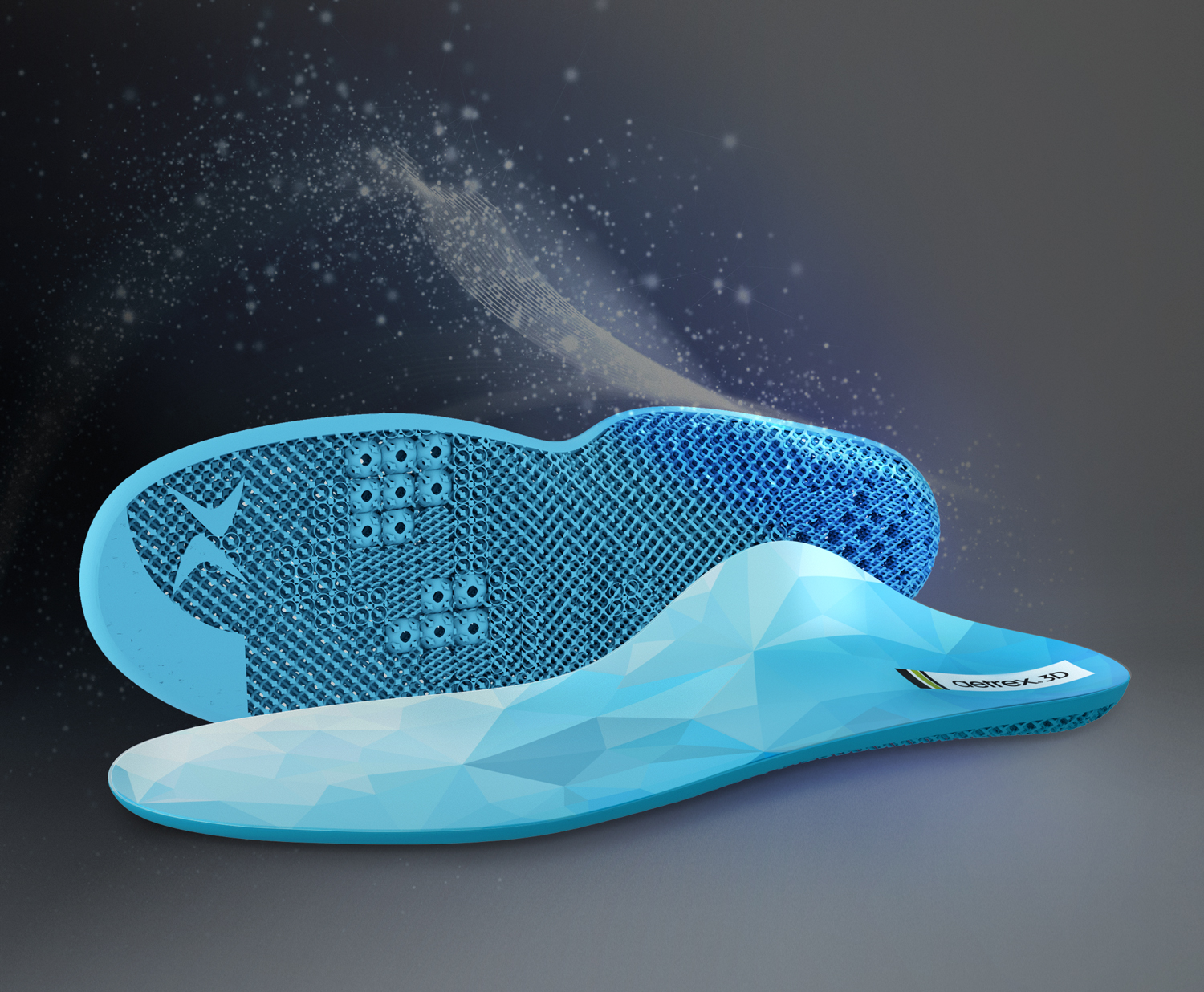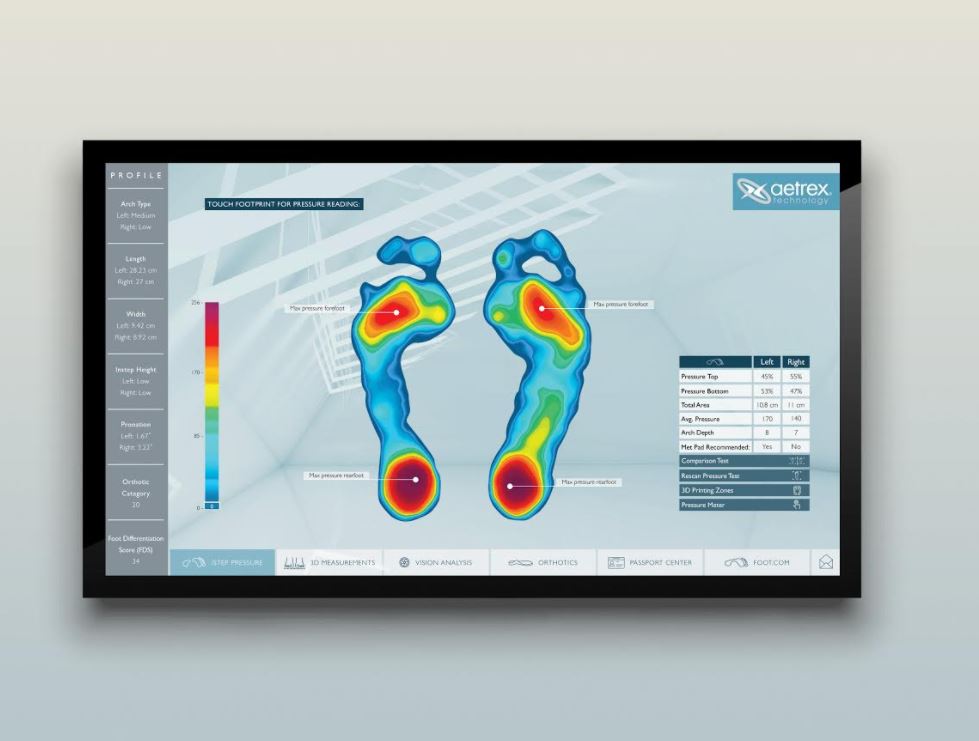In February last year, Aetrex, known for its traditionally made insole and footwear consumer products, launched its custom 3D printed orthotic program line in partnership with EOS. Just this month, the company launched its thinnest 3D printed orthotic yet – made specifically for shoes that do not have removable insoles or have very little removable depth.
These 3D printed orthotics are 3.5mm thin and made of polypropylene, and are positioned as best suited for dress shoes, loafers, cleats etc. Usable in footwear that have little to no removable bed, these orthotics not only help address common foot pain issues such as plantar fasciitis, arch pain, and metatarsalgia but also help align the back and gait as needed. Aertrex’s customized orthotic insoles are custom-made to each foot to provide the proper support and alignment for the individual’s needs, whether it’s additional support in the forefoot or rearfoot, and are shipped within a matter of days of the foot scan.
The company’s Albert foot scanner isn’t the first time it has pioneered the use of scanning in footwear. As long back as 2002, it had launched the iStep scanner. The Albert scanner, among the most advanced footwear scanners in the industry, collects a wealth of data, different for each foot of each individual, in about 30 seconds, using gold 5000 gold-plated barometric sensors, nearly 1,000 LEDS and receptors and 18 cameras integrated into software that leverages AI and computer vision technologies.
It also maps the pressure profiles, using 256 degrees of varying pressure, of each foot as it interfaces with the ground, and sent in real-time to the 3D printing solution provider, EOS, which uses its Digital Foam platform (which integrates nTopology’s software solution) to develop a latticed “digital foam” with custom 3D geometries for each square area of pressure under each foot. This material is made from TPU, with the foam’s properties resulting from highly localized spring geometries mapped to each foot. In turn, the device doesn’t just provide an exact custom fit, but also the required pressure profile for each foot.
With about 5000 scanners placed globally (300 of the latest Albert design), Aetrex is able to provide custom orthotic products to customers worldwide, on-demand for about $150. Their 3D Printed Custom Orthotics program brings transformational benefits, as the company states, to consumers and retailers alike –
“For consumers, Aetrex is able to offer a product that offsets an individual’s foot pressure, alleviates pain, brings the ground up to the foot, and places the body back to its best alignment possible. Retailers benefit from a product that requires no inventory, offers high margins and no markdowns, is season-less, and provides unmatched consumer satisfaction. The added benefit of 3D printing is the reduction of waste, and in the case of Aetrex’s 3D Printed Orthotics, the material is recyclable and gets incorporated back into the production process.
“Not only have we produced the most advanced orthotic available, we’re creating an incredible business opportunity for our partners at no risk,” said Larry Schwartz, Aetrex CEO. “Customers scan, we print and we ship – it is that easy.”
In 2017, Aetrex had acquired SOLS, a pioneer in specialized software for foot scanning and modeling, to adopt 3D scanning/printing customized solutions into its products that range from therapeutic to casual to athletic footwear and accessories for men and women. The company recognized the potential and growing demand for custom 3D printed products in the near future. The industry is growing rapidly for such custom solutions, with $4.2 billion in revenues expected by 2025 for 3D-printed footwear parts alone, and just as with highly-specialized athletic footwear (with Adidas, Nike, and New Balance), Aetrex is bringing the benefits of 3D printing to consumer footwear at scale – and their latest product is the thinnest 3D printed orthotic insole they’ve ever made.
Subscribe to Our Email Newsletter
Stay up-to-date on all the latest news from the 3D printing industry and receive information and offers from third party vendors.
You May Also Like
Profiling a Construction 3D Printing Pioneer: US Army Corps of Engineers’ Megan Kreiger
The world of construction 3D printing is still so new that the true experts can probably be counted on two hands. Among them is Megan Kreiger, Portfolio Manager of Additive...
US Army Corps of Engineers Taps Lincoln Electric & Eaton for Largest 3D Printed US Civil Works Part
The Soo Locks sit on the US-Canadian border, enabling maritime travel between Lake Superior and Lake Huron, from which ships can reach the rest of the Great Lakes. Crafts carrying...
Construction 3D Printing CEO Reflects on Being Female in Construction
Natalie Wadley, CEO of ChangeMaker3D, could hear the words of her daughter sitting next to her resounding in her head. “Mum, MUM, you’ve won!” Wadley had just won the prestigious...
1Print to Commercialize 3D Printed Coastal Resilience Solutions
1Print, a company that specializes in deploying additive construction (AC) for infrastructure projects, has entered an agreement with the University of Miami (UM) to accelerate commercialization of the SEAHIVE shoreline...
































